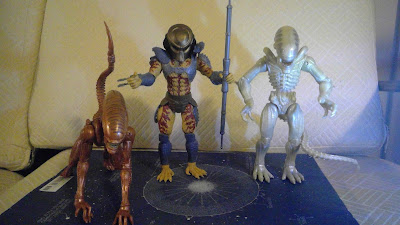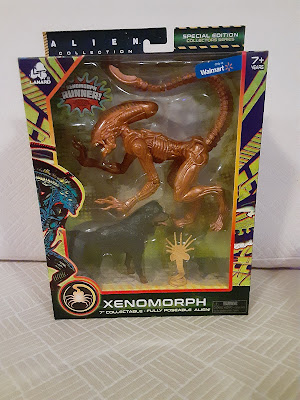Title:
Heavy Metal
What Year?:
1981
Classification:
Improbable Experiment/ Mashup/ Anachronistic Outlier
Rating:
It’s Okay! (3/4)
With this review, I’m getting to one that has felt simply inevitable. It’s a film that by my normal standards would be set aside simply because of its own success. It was well-reviewed and profitable in its own time; continually available and well-known on home video formats; and above all enduring and influential in multiple genres. Still, I have thought on and off of covering it in one of my features, particularly for the Revenant Review, but as with Creepshow, I was never satisfied it fit in there. So, I am once again turning to this feature, and I had to remind myself after that it was in fact based on a comic all along, albeit one very far from the usual comic book fare. Here at last is Heavy Metal, an animated film made from a pioneering American comic publications aimed at adults.
Our story begins with a father returning home in a 1950s muscle car launched from a space shuttle without further explanation. Unfortunately, an artifact he has brought home to his daughter turns out to be the Loc Nar, a malevolent supernatural orb representing the sum of all evils. The orb disintegrates him, then corners the kid, who is tormented with visions of others who have encountered it through time and space. We meet a cab driver who rescues a damsel from a gangster after the orb; a traveler from Earth who gets caught on a swords-and-sorcery world where two rulers fight control over the object; a renegade space captain whose trial goes awry; a stricken bomber infested by the undead; and a romance between an Earthwoman and a robot. Then we see a world where the orb unleashes a horde of irradiated barbarians on a peace-loving city, leaving the last of a race of warriors to avenge the fallen. It will all end with the confrontation between the Loc Nar and the child, and can innocence prevail over evil?
Heavy Metal was a 1981 animated film produced by Ivan Reitman based on the magazine of the same name. It was among the first animated film to be rated R, ending a period when even animated films with significant nudity and/ or violence were usually rated PG (see Allegro Non Troppo), though Fritz the Cat had received an X rating in 1972. The movie had a range of high-profile talent, including stories from Alien creator Dan O’Bannon (see Dark Star), voice acting by John Candy, Eugene Levy and Harold Ramis, and a score composed by Elmer Bernstein (see… An American Werewolf In London?). Veteran Percy Rodriguez (see… Galaxina???) voiced the Loc Nar without credit. Two of the major characters, Den and Lincoln Sterrn, had appeared in both Heavy Metal and other publications. The film had a budget of $9 million, possibly the highest for an animated film before Disney’s $44M The Black Cauldron in 1985. Unlike the latter film, it was an unquestioned box office success, with a box office of $20.1M.
For my experiences, this is one of those movies that is like an “ex” you never quite break up with. I’ve rented it on tape, bought it on used DVD, watched it on streaming, and most recently bought new on Blu Ray, and I still have trouble saying just how I feel about it. Of course, it is very historically important. Obviously, the animation is great, among other things. The sci fi/ fantasy is very high grade, augmented by a high-energy vibe and sheer audacity. The soundtrack is top-notch, with excellent orchestral music as well as a wide assortment of ‘70s/ 80s rock. Still, it has never quite connected with me on the level it clearly does for others, and I can’t quite say why. Many aspects of the animation (especially, and politely, the female characters) are awkward or entirely grotesque. Most of the storylines feel condensed and oddly stylized. Most fundamentally, there’s just not much we haven’t seen done as well or better, and not just in later adult-oriented animation that it laid the way for, but in earlier cartoons and comics like Wizards, Watership Down, and even the original Marvel Star Wars comic.
For the movie’s better points, one need look no further than my two favorite segments, “Sternn” and “B-17”, shown back to back as the third and fourth of six major storylines. The first of the two starts with an establishing shot of a space station, followed by a scrawny guy finding the Loc Nar as a small marble, which so far has been lethal on contact. The story then jumps to the courtroom, where the title character Lincoln Sternn is listening to the long list of charges against him. It’s a perfect skewering of the long tradition of the romantic rogue. Just as intriguing is the view of the courtroom, an assortment of aliens, robots and other misfits that are neither wholly realistic not openly comical. It makes me think of nothing so much as the art of Gahan Wilson, which I was introduced through in kid-friendly publications before learning of the full and raunchy extent of his work. There’s funny dialogue between Sterrn and his lawyer as the wimp takes the stand, still fidgeting with the orb, and then it all unravels. In the second segment, we see the bomber savaging and being savaged as the crew drop their bombs. As the surviving crew assess the damage, the Loc Nar arrives, and the tight, machined spaces of the plane become a deathtrap, with one brief outside view that is as horrific as the ghouls themselves.
The “other side” of this is that there are many times when the discerning genre buff will notice the movie drawing on sources much older than itself. This is most blatant in the Den segment, by my assessment the weakest, openly based on Burroughs’ John Carter saga, by my assessment with a potentially more direct debt to the proto-psychedelic Venusian tales of Leigh Brackett. The old-school approach is also very much in evidence, albeit very effective, in the Lincoln Sternn and opening Harry Canyon segments, which I find about right for the fiction of Henry Kuttner or C.M. Kornbluth. When we get to Tarrna, the final segment, the feel is like a cross between a Robert E. Howard tale, a spaghetti western and a zombie movie, with more than a hint of the much-ridiculed “space western” sci-fi subgenre. One more comparison I can’t shake, especially for the fifth segment I haven’t commented on, is the very underrated fiction of Ron Goulart, who was writing genre pastiche/ parodies throughout the proceeding decade. These tributes supply many of the movie’s best moments, but they quickly wear down its reputation as being bold or innovative for its own or any other time.
That still leaves the “one scene”, and the one that has stayed with me is from the Tarrna sequence. In the most obvious of many western references, the Terakian warrior (in my opinion the only woman in the whole movie portrayed realistically enough to be attractive) finds several of the bat-creatures used by the barbarians hitched outside the space saloon. She then witnesses one of the green-skinned goons pummel another patron just outside. The music, an incongruous number I picked out in Sky High (maybe… probably), gets louder as she enters. We then get a look at the band onstage, an assortment of robots and/or cyborgs that in some cases seem fused with their instruments. She orders a flask at the counter and takes a seat by herself. She quickly attracts the attention of the barbarians, who close in. When they go through the motions of hitting on her, she undoes a fastening on the scabbard of her sword, captured in closeup like many gestures through the movie. When the barbarians persist, she finally strikes. The music not only stops, but we see a blindfolded cyborg uncover his eyes to see what’s happening. It’s tense, nuanced and low key, at least as effective as the stylized combat that follows, exactly the kind of moment that works well enough to forget the movie’s ample flaws.
In closing, I am going to
give an anecdote of just how far this movie creeps into the mind without you
really thinking about it (see also my Transformers review). In later
2019 or early 2020, I was on a bus to work when I tried listening to “The Mob
Rules”, a song I had figured out was used for the destruction of the city in “Tarrna”.
In the midst of it, I looked around, and realized that there was somebody on
the bus carrying/ guarding a quite large television set. It was a strange sight,
even for a 20-year veteran of the public transportation system, the kind of
thing you would expect to see in footage from a disaster area or a war zone rather
than in broad daylight major metropolitan area. (The thought of taking a
picture got as far as “Hell, NO”; as I said I’m a veteran.) With the lyrics of
the song playing, it was downright eerie, enough to get me thinking about the
movie, and start the further train of thought that the apocalypse doesn’t have
to start with a horde of barbarians or a plague of zombies. It’s experiences
like this that keep a wildly self-dating movie like this relevant and thought-provoking long after
you’ve seen it. And with that, I’m done.








































